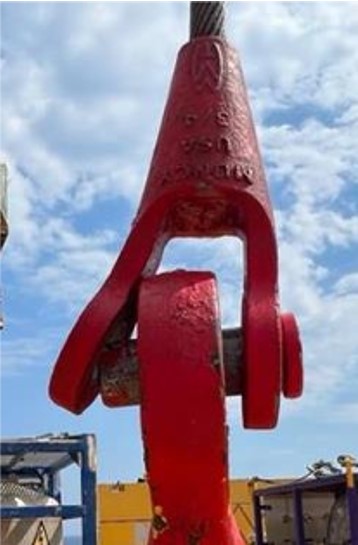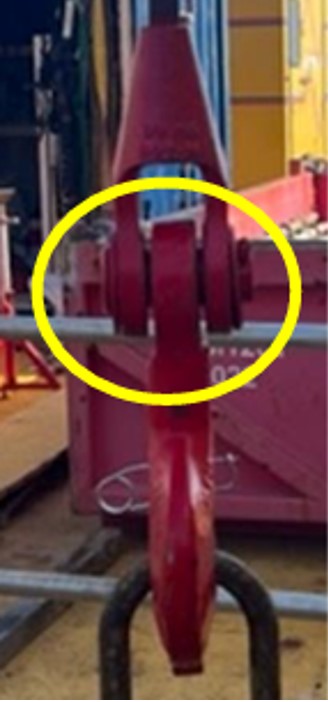Ineffective Crane Stinger Hook Pin Installation (BSEE)
What happened
The United States Bureau of Safety and Environmental Enforcement (BSEE) has published Safety Report 452 relating to a high-potential dropped object incident on a Gulf of Mexico energy facility. While using the platform crane to suspend a wireline lubricator, the pin holding the hook on the crane stinger backed out, resulting in the hook and lubricator falling. The incident caused damage to a section of the lubricator.




What went wrong
The incident investigation found that the cotter pin at the end of the hook pin had sheared (See Figure 1), which allowed the washer to fall and the pin to back out. When the pin backed out, it caused the ear on the connection to distort (See Figure 2), resulting in the hook failing. The investigation also found there was an inadequate pin configuration design. The pin installed on the hook assembly had a smooth composition (See Figure 3). The operator determined that a threaded bolt with nuts and keepers (See Figure 4) was the proper pin design for ensuring the stinger remains secure throughout lifting operations. BSEE notes that following this event, the operator inspected their other facilities and found the same improper arrangement on additional cranes.
Actions
Therefore, BSEE recommends that operators and contractors:
- Inspect all cranes on the facility and verify that the hook assembly has a threaded pin with nuts and keepers;
- Retro-fit any stingers equipped with an improper stinger hook pin configuration;
- Verify all crane components are in alignment with current manufacturer recommendations;
- Add “assessment of the pin condition” into the pre-use inspection checklist, which should be completed before conducting lifting operations.
Members may wish to refer to:
Safety Event
Published: 27 February 2023
Download: IMCA SF 06/23
IMCA Safety Flashes
Submit a Report
IMCA Safety Flashes summarise key safety matters and incidents, allowing lessons to be more easily learnt for the benefit of all. The effectiveness of the IMCA Safety Flash system depends on Members sharing information and so avoiding repeat incidents. Please consider adding [email protected] to your internal distribution list for safety alerts or manually submitting information on incidents you consider may be relevant. All information is anonymised or sanitised, as appropriate.
IMCA’s store terms and conditions (https://www.imca-int.com/legal-notices/terms/) apply to all downloads from IMCA’s website, including this document.
IMCA makes every effort to ensure the accuracy and reliability of the data contained in the documents it publishes, but IMCA shall not be liable for any guidance and/or recommendation and/or statement herein contained. The information contained in this document does not fulfil or replace any individual’s or Member's legal, regulatory or other duties or obligations in respect of their operations. Individuals and Members remain solely responsible for the safe, lawful and proper conduct of their operations.
